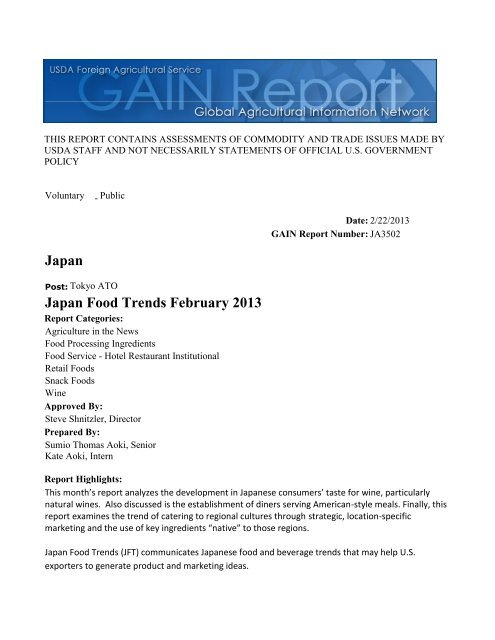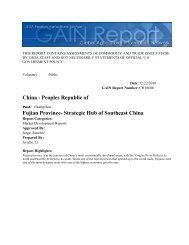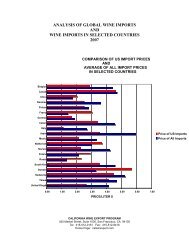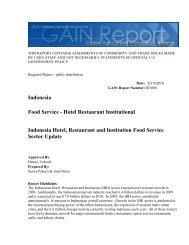Japan Food Trends February 2013 Japan - GAIN
Japan Food Trends February 2013 Japan - GAIN
Japan Food Trends February 2013 Japan - GAIN
You also want an ePaper? Increase the reach of your titles
YUMPU automatically turns print PDFs into web optimized ePapers that Google loves.
Over the past five years, American restaurants havebeen seizing the opportunity presented by <strong>Japan</strong>ese consumers’ increasing preference for Westernstyle breakfast dishes. These include both upscale venues, such as Union Square Café, as well as dinerstylerestaurants, including Eggs ‘n Things of Honolulu, and Bubby’s, a recently established New Yorkrestaurant specializing in home-style meals. Other down-home eateries establishing themselves in<strong>Japan</strong> include Sbarro pizza parlors and Mister Softee ice cream shops.These venues have proven extremely popular. Granger’s place, Eggs ‘n Things, and Bubby’s all haveexpanded beyond their initial <strong>Japan</strong> locations, attracting patrons in droves. This trend is interestingpartly because of the restaurant owners’ and chefs’ conviction that they have the responsibility tohonestly and accurately represent American cuisine, refusing to bend to <strong>Japan</strong>ese tastes. A commentfrom Ron Silver, founder and owner of Bubby’s, represents this sentiment perfectly: “I’m a chef on amission to defend the integrity of the American table.”Note from the Editor:The success of these restaurants and of Bubby’s in particular, could be the result of their managing toembody two elements that <strong>Japan</strong>ese consumers prefer in their food purchases: innovation and quality,particularly as related to the homemade image. These restaurants are new, riding the wave of theincreasing popularity of Western breakfast dishes, but also tend to convey a sense of connection to thefoods they are preparing. By bringing together two seemingly contradictory notions, innovation andhomemade foods, restaurants like Bubby’s have an opportunity for great success in <strong>Japan</strong>.Gender-Targeted Marketing“Gender-Specific Gum from Xylish”Shift East: August 7, 2012
(http://www.shifteast.com/gender-specific-gum-from-xylish/)Stacked neatly in these stylish packages, Xylish gum is marketed not according to the flavor of the gumbut to the gender of the customer. Though not traditionally seen as being exclusively feminine, theflavor Floral Rose is declared to be for ladies, and the flavor Clean Citrus for men.In some ways, this marketing strategy can be seenas a continuation of the increase seen in recent years of gender-specific marketing, particularly inregards to advertising certain snacks as being specifically for men. Interestingly, one such product wasRose Menthol Gum “Otoko no Kaoru,” from Kanebo, which emphasized to men that “This Gum is forYou”. Xylish gum has used the same strategy to insist on the opposite premise, that Rose flavored gumis for women, suggesting that this is a purely arbitrary marketing decision.Note from the Editor:Especially since these two flavors are fairly gender neutral, and because gum is enjoyed by men and womenequally, it is possible that instead of increasing their attractiveness to the relevant gender, Xylish gumhas somewhat split its consumers into those who liked the “correct” flavor given their gender andthose who did not. A quick look at this company’s website confirmed that the two flavors were nolonger listed.Rise of the “end-of-the-world” Restaurant: Variety in Canned <strong>Food</strong>s“<strong>Japan</strong>’s latest culinary cantinas?”<strong>Japan</strong> Today: July 8, 2012(http://www.japantoday.com/category/food/view/japans-latest-culinary-trend-canned-food-cantinas)
A unique restaurant in Osaka is prosperingwithout doing any cooking: at Kanso, the customers choose their meals from shelves full of cannedgoods. Customers eat standing around steel drums in a shack-like structure that is open to theelements. The food in the cans is eaten uncooked, and drinks like beer are served to compliment thenot-so-subtle tastes of these preserved foods.The shop’s appeal seems to be in the extensive variety of canned foods that they stock, made up ofover 300 varieties and includes many international foods. Kanso is even developing in-house brands.The fun seems to be in choosing freely from the extensive options, which has proved appealing tocustomers of all ages. Restaurant and café design company Clean Brothers, owner and operator ofKanso, hope to open 15 branches in <strong>Japan</strong> this fiscal year, including six in Tokyo, Osaka, and Nagoya.The first restaurant opened in 2002 in Osaka, and since Kanso required no kitchen and no speciallytrainedstaff, it had extremely low start-up costs, which will make expansion a relatively low-riskinvestment.Note from the Editor:It ispossible that part of the appeal of this type of restaurant is in its uniqueness. When it becomes a largerfranchise, it might develop the image of a supermarket where you eat the products directly from theshelves. Also, given the <strong>Japan</strong>ese focus on healthy eating, the success of such a restaurant might implyinteresting shifts in consumer tastes and demands.Catering to Regional Tastes: Location Specific Marketing and Use of Native Ingredients<strong>Food</strong> Science <strong>Japan</strong> BlogEntries: Nov. and Dec. 2012(http://foodsciencejapan.blogspot.jp/)
Famous candy brand Kit Kat and ice cream brand Haagen Dazs are embracing a region-based marketingstrategy that incorporates seasonal favorites, preference for native ingredients, and specific localtastes. This strategy’s success has made both brands widely popular throughout <strong>Japan</strong>.Both brands produce flavors that cater to the food staples of certain regions which are sold mainly inthose regions as gifts to friends in other areas and to tourists. For example, the Kit Kat variety above,Shinshu Apple, is a type of apple that is produced in Nagano Prefecture and still conveys a nostalgicimage of the region. This flavor is sold only in Nagano Prefecture. Other distinctive Kit Kat flavorsinclude Niigata Le Lectier Pear, Hokkaido Yubari Melon, Shinshu Chili Pepper, Tohoko Zunda(Edamame), Kyoto Hojicha Tea (Green tea), Nagoya Shouyu (Soy sauce) and Kyushu and OkinawaBeniimo (Purple sweet potato), each sold exclusively in the corresponding region. A favorite Kit Katflavor is Wasabi flavor from Shizuoka.Haagen Dazs produces a flavor called Murasaki Imo, which is a special kind of purple sweet potatothat is famously produced in Kagoshima and southern Kyushu. Other special Haagen Dazs flavorsinclude Pumpkin, produced using Ebisu pumpkins from Hokkaido, and Green Tea.“Kobe Beef Steak Pizza From Domino's <strong>Japan</strong> Is New Limited-Time Offering”RocketNews24: January 7, <strong>2013</strong>(http://en.rocketnews24.com/<strong>2013</strong>/01/07/the-king-of-pizzas-we-sample-dominos-pricey-new-luxurypizza-%E3%80%90food-review%E3%80%91/)Another major food brand is releasing a new variety intended to capitalize on food trends in <strong>Japan</strong>.Domino’s pizza franchise is now making a limited time pizza using Kobe Beef Steak. Kobe, a city inwestern <strong>Japan</strong>, is well known for producing high quality steak, which is featured on the pizza. It costs¥5800 JPY (US$70) and in addition to Kobe steak includes as toppings potato, onion, and deluxe steaksauce.
Note from the Editor:The production and marketing of regional flavors by international brands may make these otherwiselarger and foreign brand names seem much more friendly and personal, and have contributed to theirsuccess in <strong>Japan</strong>. Such targeted marketing seems to be increasingly common and generally successful.











